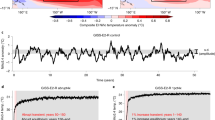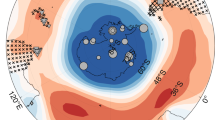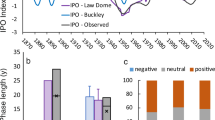Abstract
The El Niño/Southern Oscillation (ENSO) is the dominant mode of interannual climate variability on Earth, alternating between anomalously warm (El Niño) and cold (La Niña) conditions in the tropical Pacific at intervals of 2–8 years1,2. The amplitude of ENSO variability affects the occurrence and predictability of climate extremes around the world3,4, but our ability to detect and predict changes in ENSO amplitude is limited by the fact that the instrumental record is too short to characterize its natural variability5,6,7,8. Here we use the North American Drought Atlas9,10—a database of drought reconstructions based on tree-ring records—to produce a continuous, annually resolved record of ENSO variability over the past 1,100 years. Our record is in broad agreement with independent, ENSO-sensitive proxy records in the Pacific and surrounding regions. Together, these records indicate that ENSO amplitude exhibits a quasi-regular cycle of 50–90 years that is closely coupled to the tropical Pacific mean state. Anomalously warm conditions in the eastern Pacific are associated with enhanced ENSO variability, consistent with model simulations11. The quasi-periodic ENSO amplitude modulation reported here offers a key observational constraint for improving models and their prediction of ENSO behaviour linked to global warming.
This is a preview of subscription content, access via your institution
Access options
Subscribe to this journal
Receive 12 print issues and online access
$209.00 per year
only $17.42 per issue
Buy this article
- Purchase on Springer Link
- Instant access to full article PDF
Prices may be subject to local taxes which are calculated during checkout




Similar content being viewed by others
References
Deser, C., Alexander, M. A., Xie, S-P. & Phillips, A. S. Sea surface temperature variability: Patterns and mechanisms. Annu. Rev. Mar. Sci. 2, 115–143 (2010).
D'Arrigo, R., Cook, E. R., Wilson, R. J., Allan, R. & Mann, M. E. On the variability of ENSO over the past six centuries. Geophys. Res. Lett. 32, L03711 (2005).
McPhaden, M. J., Zebiak, S. E. & Glantz, M. H. ENSO as an integrating concept in Earth science. Science 314, 1740–1745 (2006).
Tang, Y., Deng, Z., Zhou, X., Cheng, Y. & Chen, D. Interdecadal variation of ENSO predictability in multiple models. J. Clim. 21, 4811–4833 (2008).
Collins, M. et al. The impact of global warming on the tropical Pacific Ocean and El Niño. Nature Geosci. 3, 391–397 (2010).
Yeh, S. W. & Kirtman, B. P. ENSO amplitude changes due to climate change projections in different coupled models. J. Clim. 20, 203–217 (2007).
Guilyardi, E. et al. Understanding El Niño in ocean–atmosphere general circulation Models: Progress and challenges. Bull. Am. Meteorol. Soc. 90, 325–340 (2009).
Wittenberg, A. T. Are historical records sufficient to constrain ENSO simulations? Geophys. Res. Lett. 36, L12702 (2009).
Cook, E. R., Woodhouse, C., Eakin, C. M., Meko, D. M. & Stahle, D. W. Long-term aridity changes in the western United States. Science 306, 1015–1018 (2004).
Cook, E. R. et al. North American Summer PDSI Reconstructions, Version 2a. IGBP PAGES/World Data Center for Paleoclimatology Data Contribution Series # 2008-046 (NOAA, NGDC Paleoclimatology Program, 2008).
Choi, J., An, S-I., DeWitte, B. & Hsieh, W.W. Interactive feedback between the tropical Pacific Decadal Oscillation and ENSO in a coupled general circulation model. J. Clim. 22, 6597–6611 (2009).
Dunbar, R. B., Wellington, G. M., Colgan, M. W. & Glymn, P. W. Eastern Pacific sea surface temperature since 1600 AD: The δ18O record of climate variability in Galápagos coral. Paleoceanography 9, 291–315 (1994).
Cobb, K. M., Charles, C. D., Cheng, H. & Edwards, R. L. El Niño/Southern Oscillation and tropical Pacific climate during the last millennium. Nature 424, 271–276 (2003).
Conroy, J. L. et al. Unprecedented recent warming of surface temperatures in the eastern tropical Pacific Ocean. Nature Geosci. 2, 46–50 (2009).
Seager, R., Kushnir, Y., Herweijer, C., Naik, N. & Velez, J. Modelling of tropical forcing of persistent droughts and pluvials over western North America: 1856–2000. J. Clim. 18, 4068–4091 (2005).
Cook, E. R., Seager, R., Cane, M. A. & Stahle, D. W. North American droughts: Reconstructions, causes and consequences. Earth Sci. Rev. 81, 93–134 (2007).
Smith, T. M., Reynolds, R. W., Peterson, T. C. & Lawrimore, J. Improvements to NOAA's historical merged land–ocean surface temperature analysis (1880–2006). J. Clim. 21, 2283–2296 (2008).
Mantua, N. J., Hare, S. R., Zhang, Y., Wallace, J. M. & Francis, R. C. A Pacific interdecadal climate oscillation with impacts on salmon production. Bull. Am. Meteorol. Soc. 78, 1069–1079 (1997).
Zhang, Y., Wallace, J. & Battisti, D. ENSO-like decade-to-century scale variability: 1900–93. J. Clim. 10, 1004–1020 (1997).
Lanzante, J. R. Resistant, robust & non-parametric techniques for the analysis of climate data: Theory and examples, including applications to historical radiosonde station data. Int. J. Climatol. 16, 1197–1226 (1996).
Mann, M. E. & Lees, J. Robust estimation of background noise and signal detection in climatic time series. Clim. Change 33, 409–445 (1996).
Torrence, C. & Compo, G. P. A practical guide to wavelet analysis. Bull. Am. Meteorol. Soc. 79, 61–78 (1998).
LaMarche, V. C. Jr., Holmes, R. L., Dunwiddie, P. W. & Drew, L. G. Tree-ring chronologies of the southern hemisphere: Chile. Lab. Tree-Ring Res. Chronol. Ser. 2, 1–43 (1979).
Buckley, B. M. et al. Climate as a contributing factor in the demise of Angkor, Cambodia. Proc. Natl Acad. Sci. USA 107, 6748–6752 (2010).
Fedorov, A. V. & Philander, S. G. A stability analysis of the tropical ocean–atmosphere interactions: Bridging measurements and theory for El Niño. J. Clim. 14, 3086–3101 (2001).
Hodell, D. A. et al. Climate change on the Yucatan Peninsula during the Little Ice Age. Quat. Res. 63, 109–121 (2005).
Nelson, D. B. et al. Drought variability in the Pacific Northwest from a 6,000-yr lake sediment record. Proc. Natl Acad. Sci. USA 10.1073/pnas.1009194108 (2011).
Burgman, R. J., Schopf, P. & Kirtman, B. P. Decadal modulation of ENSO in a hybrid coupled model. J. Clim. 21, 5482–5500 (2008).
Mann, M. E., Cane, M. A., Zebiak, S. E. & Clement, A. Volcanic and solar forcing of the tropical Pacific over the past 1,000 years. J. Clim. 18, 447–456 (2005).
Duchon, C. E. Lanczos filtering in one and two dimensions. J. Appl. Meteorol. 18, 1016–1022 (1979).
Acknowledgements
We gratefully acknowledge the researchers who have contributed their tree-ring data for NADA development. This research was funded by the National Science Foundation, the National Oceanic and Atmospheric Administration, the Japan Agency for Marine-Earth Science and Technology, the National Basic Research Program of China (2011CB309704), and the National Science Foundation of China (No.40890155). This is a International Pacific Research Center/School of Ocean and Earth Science and Technology Contribution (774/8128) and a Lamont–Doherty Earth Observatory Contribution (7462).
Author information
Authors and Affiliations
Contributions
J.L., S-P.X. and E.R.C. contributed to data analysis. J.L., S-P.X., E.R.C., G.H., and R.D. contributed to writing the paper. All authors discussed the results and commented on the manuscript.
Corresponding author
Ethics declarations
Competing interests
The authors declare no competing financial interests.
Supplementary information
Rights and permissions
About this article
Cite this article
Li, J., Xie, SP., Cook, E. et al. Interdecadal modulation of El Niño amplitude during the past millennium. Nature Clim Change 1, 114–118 (2011). https://doi.org/10.1038/nclimate1086
Received:
Accepted:
Published:
Issue Date:
DOI: https://doi.org/10.1038/nclimate1086
This article is cited by
-
The mean state of the tropical Pacific Ocean differed between the Medieval Warm Period and the Industrial Era
Communications Earth & Environment (2023)
-
Interdecadal wind stress variability over the tropical Pacific causes ENSO diversity in an intermediate coupled model
Climate Dynamics (2023)
-
A precipitation reconstruction based on pinyon pine tree rings from the northeastern Mexican subtropic
Theoretical and Applied Climatology (2023)
-
Southern Hemisphere Volcanism Triggered Multi-year La Niñas during the Last Millennium
Advances in Atmospheric Sciences (2023)
-
Stability of ENSO teleconnections during the last millennium in CESM
Climate Dynamics (2023)



